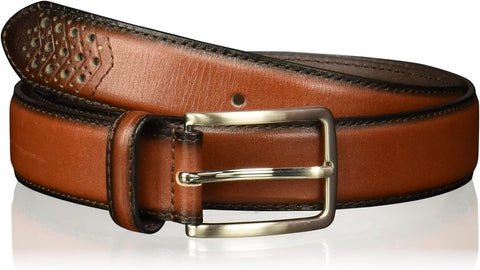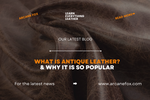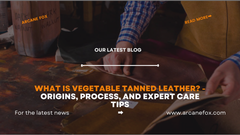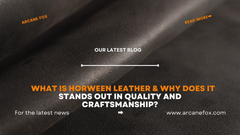What is Burnished Leather? & Why Should It’s Be Your Top Choice

What is Burnished Leather? & Why Should It’s Be Your Top Choice
Leather continues to be a timeless, allure-enduring material. When made of leather, items like shoes, bags, belts, and furniture get an additional level of refinement and sophistication. Burnished leather is one of the most sought-after leather treatments.
This essay will examine the attractiveness of burnished leather and explain why it should be your first choice when making your next purchase. It is a beautiful, strong, and long-lasting material.
1. What is Burnished Leather?

Burnished leather refers to any variety of leather that has undergone polishing or buffing to achieve its distinctive textured surface. To produce burnished leather, polishing requires either using hand tools such as burnishers or employing mechanical devices like rotary burnishing machines until its surface reaches a state that becomes smooth and glossy - this process may occur via mechanical means such as rotating drum machines.
Burnished leather adds depth and personality to any object with its matte or semi-glossy surface, creating an eye-catching contrast against matte or semi-glossy surfaces. Its look depends on how extensive its burnishing was apply; some items boast subtler tones while others boast bolder ones.
The beautiful aging of burnished leather, which develops a patina over time, is one of its main advantages. The leather darkens and develops a gloss as a result of the patina, which is brought on by exposure to air, light, and natural oils. This gives burnished leather goods a unique appeal that cannot be imitate.
From a variety of animal hides, including cowhide, sheepskin, and goat leather, burnished leather can be made. Every type of leather has a unique texture and appearance that are determine by the tanning procedure and the level of burnishing use.
2. Clearing Up Myths & Misconceptions
One widespread misunderstanding is that only leather that has been vegetable-tanned can be polished. All leathers have the ability to be burnished, even though this type of leather is by far the simplest to burnish. Even the most fuzzy edges can be gradually smooth down to give the appearance of being slicked with the use of burnishing pastes.
Crafters are discourage from relying on burnishing with other leathers and choose edge paint or other finishing techniques instead because chromium-based leathers frequently get fuzzy earlier than vegetable-tanned leather.
3. Where Burnished Leather Comes From?

Burnished leather may be found all throughout the world, with some of the best examples coming from Mexico, Spain, and Italy. These countries are known for their outstanding leather and for having talented craftspeople who produce polished leather goods using age-old techniques.
Burnished leather is a popular option among high-end fashion manufacturers in Italy. Italian craftsmen produce beautiful, long-lasting burnished leather using traditional tanning procedures and hand-finishing techniques. Shoes, purses, and other fashion accessories sold in luxury shops and department stores around the world are frequently made with this Italian specialty.
Read More: Everything You Need to Know About Italian Leather Craftsmanship
Spain is widely river for producing quality leather craftsmanship and products, such as classic footwear such as espadrilles and loafers made of burnished Spanish leather that combine style with comfort, and fashion-conscious consumers often purchase handbags, belts and other leather accessories from this nation.
Polished leather has become an increasingly popular material used to craft Western-themed products in Mexico, especially cowboy boots and related wear.
Through traditional tanning and finishing methods use by artisans, high-quality burnished leather that's both tough and stylish can be create - which you may come across when browsing online shops offering Western wear or visiting traditional Western wear shops.
4. Where Does The Term Burnished Leather Come From?
The term "burnished leather" comes from the activity of burnishing, which involves using a burnishing tool or cloth to polish and smooth the surface of leather. The word "burnish" derives from the Old French verb "burnie," which means "to make shine." This term has been use to describe the process of polishing metals or other things since the Middle Ages.
5. Reasons You Might Choose To Burnish Leather

Burnishing leather is most frequently done to seal and polish the edges. Without it, leather edges will eventually become fuzzy and roll. By polishing the edge, burning not only stops this but also gives the surface a refined appearance.
The surface and flesh side of leather can both be shine. The leather's oils can be seen by burnishing the surface, allowing for polishing. This is typical of footwear, where maintaining the appearance of oxfords or other shoes requires regular polishing.
Any loose fibers on the flesh side of the leather can be press down by burnishing, giving the leather a smooth backside. This can be a great option for those not lining their leather products, as a burnished flesh side will look well finished.
6. Skill Level of Burnishing Leather
Basic leather burnishing is a straightforward task that doesn't call for any special leatherworking abilities. The surface of the leather that will be treat is coat with water or a burnishing paste, and can then be rubb with a variety of materials. This is sufficient to smooth the leather down and start polishing it.
Sanding may be advise for a glossier finish, beginning with 220 grit paper and moving up to 1000+. The final edge will be more shiny the smoother the leather becomes. Sanding should only be done on the edge of the leather because doing so can harm both the surface and the flesh side.
7. Who Invented Burnished Leather?

Burnishing leather has been practice for millennia, making its exact origin difficult to pinpoint. Historians speculate that ancient Egyptians and Greeks were among the first people to employ burnishing techniques when crafting leather items that were both durable and visually appealing.
Leather was an invaluable commodity in ancient Egypt, used for clothing, furniture, and other accessories. Egyptians employed vegetable tanning techniques to transform animal hides into leather before polishing them using burnishing tools for smooth finishing and polished surface finishes.
Ancient Greeks were widely recognize for their skilled leather craftsmanship, using it for clothing, armor, and footwear. Like their Egyptian counterparts, they employed burnishing instruments for creating polished finishes on leather surfaces.
Burnishing leather has developed over time, with artisans employing various materials and tools to achieve their desired result. Today, this technique remains popular with leatherworkers and craftsmen worldwide for creating beautiful items made out of this timeless medium.
Even though its inventor is unknown, burnished leather boasts an extensive history that continues to be appreciate for both its elegance and longevity.
8. How To Burnish Leather?
Burnishing leather creates a glossy, slick edge that is both aesthetic and functional. The friction from burnishing seals the leather's edge, locking in natural oils and moisture while creating a waterproof barrier that prevents thread rot.
This process works best on vegetable-tanned leather, particularly after dyeing, to achieve a high-gloss finish.
8.1 Hand Burnisher
Hand burnishers, often made of wood, plastic, or glass, are grooved to accommodate different leather weights. Before burnishing, sand the edges to ensure smoothness and remove excess glue.
Then, bevel the edges for a rounded look. Apply a lubricant like water, beeswax, gum tragacanth, or saddle soap to the edge, as these compounds heat up and smoothen the leather fibers.
Run the burnisher along the edge with pressure to generate friction, repeating the process as needed. For extra shine, buff with a canvas cloth and optional oil or wax.

8.2 Burnishing Machine
Machine-powered burnishers, such as table-mounted tools or rotary attachments, simplify the process.
These tools often include sanding drums and grooved tips for a variety of leather weights.
Follow the same steps as hand burnishing: sand, bevel, lubricate, and burnish. Monitor the machine's speed to avoid burning the leather.

9. What are Characteristics of Burnish Leather ?
Burnished leather varies from other types of leather in various ways, including the following:
9.1 Unique Texture
Because the leather surface has been polish or buff, burnished leather has a distinctive texture. Depending on the desired effect, the texture can range from a matte to a semi-glossy finish. The leather is given this texture by being rubbed with a burnishing tool or cloth until it turns smooth and lustrous.
9.2 Vibrant Color
Natural dyes are use to produce a variety of rich, vibrant colors in burnished leather. The color of the leather intensifies with time, adding charm and beauty. Compared to other leather kinds, burnished leather frequently has deeper, more saturated colors, giving it a more opulent appearance.
9.3 Patina
A natural patina that gives burnished leather a distinct personality and increases its beauty develops as it ages. The leather darkens and acquires a gloss as a result of the patina, which is create when it is expose to air, light, and natural oils. Each piece of burnished leather is unique due to the varying patina that can be seen between objects.
10. What are the Advantages and Disadvantages of Burnished Leather?
10.1 Advantages of Burnished Leather:
- Durability: Burnished leather ranks as one of the most durable types. Able to withstand regular wear-and-tear, water resistance and stain protection make this leather an excellent option for shoes, bags, and furniture that will undergo frequent usage.
- Timeless Style: Burnished leather offers timeless yet classic style with its rich colors and distinctive texture that add character and sophistication. An ideal material choice for high-quality items with lasting quality.
- Versatility: Burnished leather can be found on various items, from shoes and bags to belts and furniture. Thanks to its adaptable nature, this material can fit seamlessly into any environment or occasion.
- Natural Patina: Burnished leather develops its own special patina over time due to exposure to air, light, and natural oils. This unique finish gives each item its own special sheen and hue that cannot be duplicate elsewhere.
10.2 Disadvantages of Burnished Leather:
- Cost: Burnished leather tends to be more costly than its counterparts due to the additional time and effort needed to produce its distinctive effect, including more steps during production which add more costs than expected.
- Maintenance: Burnished leather requires extra maintenance compared to other leather types. Regular cleaning and conditioning must take place to preserve its look. Failing to take this care could result in cracking and drying which lead to expensive repairs down the line.
- Limited Color Options: Although burnished leather comes in an assortment of vibrant hues, its selection may still be more limited compare to other leather varieties - this could prove detrimental if one wishes for a specific hue or shade.
11. What Burnished Leather is Used For?
Burnished leather is an exceptional material with many applications in fashion and furniture alike. From fashionable footwear to sophisticated furniture pieces. Thanks to its distinctive texture and matte or semi-gloss finish. It has quickly become one of the go-to choices among those who appreciate its elegance. Let's explore all its uses more closely now.
11.1Leather Shoes

Shoes made of burnished leather are a popular choice, from casual boots to dress shoes for both men and women. Their classic aesthetic adds sophistication, though due to the extra time and labor necessary. Burnished leather shoes tend to cost more than other forms.
11.2 Leather Bags
Burnished leather bags provide stylish yet practical accessories, from clutch to tote sizes. Additionally, their durability often outclasses other leather types to accommodate heavy use.
11.3 Leather Belts

Burnished leather belts are timeless staples that never go out of fashion; adding sophistication and class to any ensemble, be it formal or casual wear. Although more costly than other leather options, their timeless beauty makes this investment worthwhile.
11.4 Leather Furniture
Burnished leather furniture offers both style and durability for years of enjoyment. Although burnished leather chairs, sofas, and ottomans tend to cost more than other forms of leather furnishings. Their unique texture adds great aesthetic value and natural patina adds character.
Burnished leather accessories such as wallets, watchbands, and phone cases tend to be more durable than their leather counterparts and can withstand daily usage without showing signs of wear and tear.
Burnished leather can also be utilize in specialty applications like motorcycle jackets, horse saddles, and musical instrument cases. Where its unique texture and appearance add an attractive visual component.
12. How to Identify Burnished Leather?

Burnished leather stands out with its distinctive quality and appearance, easily distinguishing it as genuine burnished leather. To identify it properly, look out for its distinctive characteristics such as:
12.1 Texture
Burnished leather distinctive texture results from a process involving buffing or polishing its surface, producing either a matte or semi-glossy finish with an elegant and refined aesthetic.
12.2 Color
Burnished leather boasts vibrant and rich hues from natural dyes used during its creation process. As time progresses, its hue deepens further adding charm and allure.
12.3 Patina
Over time, burnished leather develops its own natural patina through exposure to air, light, and natural oils in its environment - further increasing its charm. This patina lends the leather an inimitable charm which only further heightens its aesthetic beauty.
12.4 Grain
Burnished leather natural grain stands out as another distinctive characteristic. Each pieces pattern of grain makes each piece uniquely its own and contributes to its unique character.
12.5 Smell
High-grade burnished leather exudes its own distinct leather aroma that should not overpower or overwhelm.
When purchasing burnished leather products, make sure they are authentic by carefully inspecting their texture, color and patina as well as tactile properties to determine whether it feels like premium leather. Be wary of products claiming to be burnish leather but lacking hallmarks indicative of real leather products.
If you have doubts that an item is made of burnished leather, inquire further from its retailer or seller. They should provide details about both the type and technique employed to achieve that burnished effect.
13. How Does Burnished Leather Compare to Similar Leather Types?
There are many different leather varieties available to choose from. Each having a unique combination of qualities and benefits, for leather fans. How does burnished leather stack up to the other options they have given its great texture, vibrant color, and natural patina?
13.1 Full-grain leather
Full-grain leather is a premium leather product compose of rawhide that hasn't undergone any polishing. Sanding or other treatment to alter its natural look and maintain resilience and strength. Although polish leather has various textures and finishes, full-grain leather is frequently favorer because it has a more unspoil natural appeal and surface quality that works well for belts or handbags.

13.2 Suede Leather
Suede leather, on the other hand, has been process through buffing to create its signature soft fuzzy surface. While burnished leather features either matte or semi-gloss finishes. Suede plush velvety feel provides additional breathability and comfort - ideal features when selecting shoes and jackets to wear!

13.3 Patent Leather
Unlike burnished leather, which has a rustic appearance, patent leather is a type of leather that has an ultra-high gloss coating placed over it to give it a bright and polished appearance. Patent leather is also known for being long-lasting as well as being resistant to water and stains; making it a popular choice in shoes and handbags alike.

13.4 Distressed leather
Unlike polished leather, which over time acquires an aged patina, distressed leather is intentionally made to look worn and distressed. In addition to being soft and supple, distressed leather is a preferred material for jackets and bags.

13.5 Burnished leather
In terms of attributes and traits, burnished leather stands out as an attractive specialty type of leather that is unique from others. Although each type of leather has its own benefits and characteristics. Burnished leather is a favorite among people who value the beauty and durability of leather because of its distinctive textures, colors, and patina.
14. How to Clean & Care for Burnished Leather?

To keep burnished leather looking good and lasting long, it must be properly care for. The following are some cleaning and maintenance hints for objects made of polished leather:
14.1 How to Clean Burnished Leather?
Apply a leather conditioner to keep the leather supple and smooth. With the use of leather conditioners, leather is kept from drying out, splitting, or stiffening over time. Apply a conditioner made especially for burnished leather as directed by the manufacturer.
A soft, dry cloth with a small amount of conditioner apply to it should be use to gently rub the leather in a circular motion. After giving the leather some time to absorb the conditioner, remove any extra with a fresh, dry cloth.
14.2 How to Care for Burnished Leather?
Apply a leather conditioner to maintain the leather's softness and suppleness. In the long run, leather conditioners stop the material from drying out, splitting, or stiffening.
Follow the manufacturer's recommendations when using a conditioner made especially for burnished leather. Use a soft, dry cloth and a small amount of conditioner to gently rub the leather in a circular motion. Allow the conditioner to soak into the leather for a few minutes before removing any extra with a fresh, dry cloth.
14.3 How to Store Burnished Leather?
Keep your polished leather products cool and dry when not in use, out of direct sunlight and moist areas when storing. A dust bag or cover should protect them from dirt, scuffs and any possible creasing or wrinkles cause by stacking them up or being compress too tightly against each other.
14.4 How to Repair Burnished Leather?
Take your burnished leather item to a reputable leather repair business for repairs if it sustains damage. Avoid trying to fix the leather yourself because you can end up doing more harm.
15. Conclusion
Any object benefits from the distinctive beauty and depth of burnished leather. Its unusual texture, vibrant color, and all-natural patina make it a highly desired finish among leather enthusiasts worldwide.
For people who value timeless style and longevity, burnished leather is worth the investment even if it may be more expensive and maintenance-intensive than other varieties of leather. You can make sure that the products you purchase in burnished leather will last for many years by following the instructions on how to care for and recognize it.
Learn more about leather here Leather 101 - The Ultimate Guide to Different Types of Leather
Related Topics
- How is Leather Made? A Step-by-Step Guide of the Leather Tanning Process
- What is Aniline Leather? Types of Aniline, Characteristics, And More
- What is Semi-Aniline Leather? History, Characteristics, And More
- What is Antique Leather? & Why it is So Popular
- What is Bicast Leather? Myths, Facts, and Benefits
- What is Embossed Leather? & How to Use This Process
- What is Embroidery Leather? & What to Look for In Leather Embroidery?
- What is Faux Leather? It’s Quality & Durability Against Other Leather!
- What is Nappa Leather? Quality, Characteristics, and Maintenance
- What is Nubuck Leather? & How is it Different From Suede Leather
- What is Oil or Pull-Up Leather? It’s Durability, Characteristics, and Maintenance
- What is Patent Leather? & How to Maintain It’s Quality and Shining
- What is Pigmented Leather? How is it Made, It's uses and characteristics
- What is Distressed Leather - How It’s Made and What Makes It Unique





